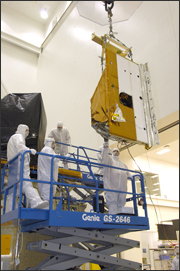Source: NASA

The engineering team at NASA’s Goddard Space Flight Center in Greenbelt, Md., built TIRS on an accelerated schedule, going from a design on paper to a completed instrument in 43 months. An instrument of this type usually takes another year to complete.
Under contract to NASA, Orbital is responsible for providing the spacecraft bus, installing the science instruments and performing system-level integration and testing of the Observatory prior to launch. Ball Aerospace & Technologies Corp. built the OLI. The USGS developed the LDCM ground system.
LDCM is on schedule for launch on Feb. 11, 2013.
Further Information:
+ Landsat’s Thermal Infrared Sensor Arrives at Orbital (02.14.12)
+ Information on LDCM’s instruments

How Early Astronaut Photographs Inspired the Landsat Program
In the 1960s, NASA was pioneering a new era of human spaceflight—and astronaut photography—that would change Earth observation forever.




